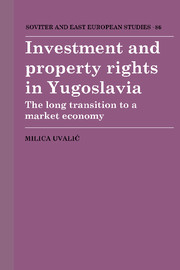Book contents
- Frontmatter
- Contents
- List of figures
- List of tables
- Preface and acknowledgements
- Introduction
- Part I The institutional and theoretical framework
- 1 The Yugoslav road towards market socialism
- 2 The investment theory of the labour-managed firm
- 3 Extensions of the LMF investment theory
- 4 The investment behaviour of the socialist firm
- Part II Empirical evidence on the nature of the Yugoslav system
- Part III Pressure for more radical reforms in Yugoslavia
- Notes
- List of references
- Index
- Series list
2 - The investment theory of the labour-managed firm
Published online by Cambridge University Press: 11 January 2010
- Frontmatter
- Contents
- List of figures
- List of tables
- Preface and acknowledgements
- Introduction
- Part I The institutional and theoretical framework
- 1 The Yugoslav road towards market socialism
- 2 The investment theory of the labour-managed firm
- 3 Extensions of the LMF investment theory
- 4 The investment behaviour of the socialist firm
- Part II Empirical evidence on the nature of the Yugoslav system
- Part III Pressure for more radical reforms in Yugoslavia
- Notes
- List of references
- Index
- Series list
Summary
The economic theory of the labour-managed firm (LMF) has been developed by Benjamin Ward (1958), Jaroslav Vanek (1970), James Meade (1972) and a number of other scholars. Although Ward's model was originally inspired by the Yugoslav (‘Illyrian’) system of selfmanagement, the concept of the LMF has in the mean time been extended to include producer cooperatives in Western economies. Thus today, in the growing theoretical literature, the LMF refers to both the self-managed socialist firm in Yugoslavia and the workers' cooperative in Western countries; both types of firm are considered to have the following principal features in common (Nuti 1988b): (1) selfmanagement, i.e. participation of all workers in decision-making on all major policy issues, usually on the basis of the principle of one person one vote, directly or through representative organs; (2) an egalitarian system of profit distribution; and (3) collective ownership of capital – which implies certain restrictions on the appropriability of net assets.
Given these specific features, the LMF has been distinguished for its objective function (Ward 1958, Vanek 1970). In contrast with the capitalist firm, which maximizes total profits, the LMF is assumed to maximize income per worker. Such enterprise behaviour is capable of supporting the same kind of long-term equilibrium achievable by an economy with traditional capitalist firms (see Vanek 1970); in the short run, however, the difference in maximands is expected to lead to a number of inefficiencies of the LMF with respect to the capitalist firm (see Nuti 1988b).
- Type
- Chapter
- Information
- Investment and Property Rights in YugoslaviaThe Long Transition to a Market Economy, pp. 17 - 28Publisher: Cambridge University PressPrint publication year: 1992



